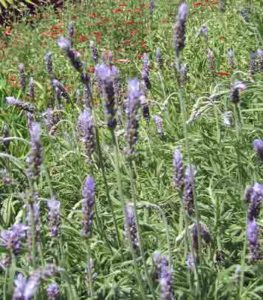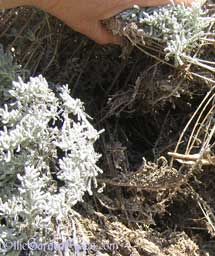 Here is one of my favorite plants; lavender. I have two French lavender plants growing in my garden. Both have been flowering for months now and both have proven to be extremely drought tolerant and beautiful. Even lavender leaves are sticky with essential oils and perfume the air. I use the flowers and leaves for filling in bouquets and let branches dry in the bathroom. They can also be used for flavoring in salads or vinegar.
Here is one of my favorite plants; lavender. I have two French lavender plants growing in my garden. Both have been flowering for months now and both have proven to be extremely drought tolerant and beautiful. Even lavender leaves are sticky with essential oils and perfume the air. I use the flowers and leaves for filling in bouquets and let branches dry in the bathroom. They can also be used for flavoring in salads or vinegar.
Two of the more popular home garden forms are French lavender (Lavandula dentata) and English lavender (lavandula angustifolia, l. officinalis). French lavender reaches 3 to 4 tall and 4 to 6 feet wide and is more drought tolerant with more compact flowers. English Lavender plants are smaller, reaching only about 2 feet high and wide. The English variety is known to be shorter-lived (3 to 5 years), but is considered to have a more complex fragrance.
Lavender is an aromatic herb grown for centuries and appreciated for its fragrant, purplish blue flowers. These drought-tolerant shrubs take full sun to partial shade outdoors. They can take moderate water, but can also survive in low water gardens once established (usually after a year). The flowers bloom on long, square-shaped stalks and buds can be up to two inches long.
I Drought Tolerant Lavender – planted my first plant near the house where my plants may get an extra splash of water. It held up so well, I planted another one in The Back 40. As my readers may know, The Back 40 has a very laissez-faire watering schedule. Given the drought and water restrictions, that means my schedule is perhaps more lazy than fair. The second one (which basically lives off our average 7 inches of rainfall a year) has spread about 4 feet wide and is about 4 feet tall now. The flowers are heavenly.
 Thatchy Plants – When lavender plants mature, they have narrow green or gray green needle shaped leaves on woody branches. They are great in rock gardens, dry herb gardens or as low, informal hedges. They add structure to the landscape with their evergreen leaves and are a good height for the middle of the flower bed. Mix lavender shrubs in with other drought tolerant herbs like rosemary and sage to enjoy their fragrance mixture on hot summer nights.
Thatchy Plants – When lavender plants mature, they have narrow green or gray green needle shaped leaves on woody branches. They are great in rock gardens, dry herb gardens or as low, informal hedges. They add structure to the landscape with their evergreen leaves and are a good height for the middle of the flower bed. Mix lavender shrubs in with other drought tolerant herbs like rosemary and sage to enjoy their fragrance mixture on hot summer nights.
After the second year or so, thee small shrubs can develop a dry thatch, or collection of dry leaves on the inside of the shrub. The plant can develop long spindly branches. This means it is time to prune back your plants. Fall is usually the best time to do this, especially in mild winter areas. To make your lavender will grow back thick and fresh, trim the branches back to about 10 inches. I like to trim mine back in phases so the plant doesn’t look so bald, and bring the branches indoors to freshen things up.
Lavender Lore – The intoxicating scent of lavender has been used in love potions, perfumes and soaps for centuries. It is also credited with the ability to promote chastity. It has been worn to elevate moods and used in aromatherapy to cure nervous depression. In Victorian times a gift of lavender flowers could mean either loyalty or mistrust. Modern science has discovered that lavender oil has antispasmodic, antidepressant and carminative properties.
 An old recipe called “Four Thieves Vinegar” was used in 1630 to combat the Great Plague in France. It was a combination of thyme, lavender, rosemary and sage steeped in vinegar. It got the name from a group of thieves who looted the city without getting sick. Their death sentence was commuted in order to discover their secret to not catching the disease themselves.
An old recipe called “Four Thieves Vinegar” was used in 1630 to combat the Great Plague in France. It was a combination of thyme, lavender, rosemary and sage steeped in vinegar. It got the name from a group of thieves who looted the city without getting sick. Their death sentence was commuted in order to discover their secret to not catching the disease themselves.
In the past, lavender was used as a ‘strewing herb’ in hospitals and homes to disinfect and clear the air. Dried blossoms make excellent potpourri and can be tied up in cotton fabric before being tucked into drawers or linen closets. Using this herb in your closets also has a practical side; it also has insecticidal properties.
Lavender plants hardy to USDA Zone 6 or 40 degrees Fahrenheit. Mine have survived light frosts without a problem. You might be able to get them through a cold snap with an extra shovel-full of mulch or a frost blanket.
These photos are all of French lavender. Close your eyes and imagine their scent. There. Feel better?
Happy gardening!
Nice! You can never go wrong with Lavender.